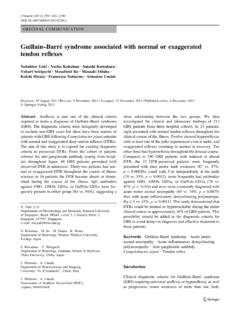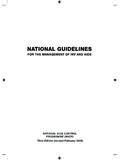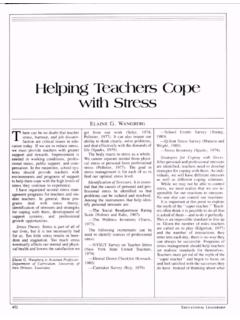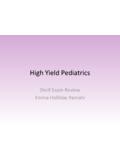Transcription of POSITIVE AND NEGATIVE SYNDROME SCALE (PANSS) …
1 POSITIVE AND NEGATIVE SYNDROME SCALE (PANSS) RATING CRITERIA GENERAL RATING INSTRUCTIONS Data gathered from this assessment procedure are applied to the PANSS ratings. Each of the 30 items is accompanied by a specific definition as well as detailed anchoring criteria for all seven rating points. These seven points represent increasing levels of psychopathology, as follows: 1- absent 2- minimal 3- mild 4- moderate 5- moderate severe 6- severe 7- extreme In assigning ratings, one first considers whether an item is at all present, as judging by its definition. If the item is absent, it is scored 1, whereas if it is present one must determine its severity by reference to the particular criteria from the anchoring points.
2 The highest applicable rating point is always assigned, even if the patient meets criteria for lower points as well. In judging the level of severity, the rater must utilise a holistic perspective in deciding which anchoring point best characterises the patient s functioning and rate accordingly, whether or not all elements of the description are observed. The rating points of 2 to 7 correspond to incremental levels of symptom severity: A rating of 2 (minimal) denotes questionable or subtle or suspected pathology, or it also may allude to the extreme end of the normal range.
3 A rating of 3 (mild) is indicative of a symptom whose presence is clearly established but not pronounced and interferes little in day-to-day functioning. A rating of 4 (moderate) characterises a symptom which, though representing a serious problem, either occurs only occasionally or intrudes on daily life only to a moderate extent. A rating of 5 (moderate severe) indicates marked manifestations that distinctly impact on one s functioning but are not all-consuming and usually can be contained at will. A rating of 6 (severe) represents gross pathology that is present very frequently, proves highly disruptive to one s life, and often calls for direct supervision.
4 A rating of 7 (extreme) refers to the most serious level of psychopathology, whereby the manifestations drastically interfere in most or all major life functions, typically necessitating close supervision and assistance in many areas. Each item is rated in consultation with the definitions and criteria provided in this manual. The ratings are rendered on the PANSS rating form overleaf by encircling the appropriate number following each dimension. PANSS RATING FORM absent minimalmild moderatemoderate severe severe extreme P1 Delusions 1 2 3 4 5 6 7 P2 Conceptual disorganisation 1 2 3 4 5 6 7 P3 Hallucinatory behaviour 1 2 3 4 5 6
5 7 P4 Excitement 1 2 3 4 5 6 7 P5 Grandiosity 1 2 3 4 5 6 7 P6 Suspiciousness/persecution 1 2 3 4 5 6 7 P7 Hostility 1 2 3 4 5 6 7 N1 Blunted affect 1 2 3 4 5 6 7 N2 Emotional withdrawal 1 2 3 4 5 6 7 N3 Poor rapport 1 2 3 4 5 6
6 7 N4 Passive/apathetic social withdrawal 1 2 3 4 5 6 7 N 5 Difficulty in abstract thinking 1 2 3 4 5 6 7 N6 Lack of spontaneity & flow of conversation 1 2 3 4 5 6 7 N7 Stereotyped thinking 1 2 3 4 5 6 7 G1 Somatic concern 1 2 3 4 5 6 7 G2 Anxiety 1 2 3 4 5 6 7 G3 Guilt feelings 1 2 3 4 5
7 6 7 G4 Tension 1 2 3 4 5 6 7 G5 Mannerisms & posturing 1 2 3 4 5 6 7 G6 Depression 1 2 3 4 5 6 7 G7 Motor retardation 1 2 3 4 5 6 7 G8 Uncooperativeness 1 2 3 4 5 6 7 G9 Unusual thought content 1 2 3 4 5 6 7 G10 Disorientation 1 2 3 4 5 6
8 7 G11 Poor attention 1 2 3 4 5 6 7 G12 Lack of judgement & insight 1 2 3 4 5 6 7 G13 Disturbance of volition 1 2 3 4 5 6 7 G14 Poor impulse control 1 2 3 4 5 6 7 G15 Preoccupation 1 2 3 4 5 6 7 G16 Active social avoidance 1 2 3 4 5 6 7 SCORING INSTRUCTIONS Of the 30 items included in the PANSS, 7 constitute a POSITIVE SCALE , 7 a NEGATIVE SCALE .
9 And the remaining 16 a General Psychopathology SCALE . The scores for these scales are arrived at by summation of ratings across component items. Therefore, the potential ranges are 7 to 49 for the POSITIVE and NEGATIVE Scales, and 16 to 112 for the General Psychopathology SCALE . In addition to these measures, a Composite SCALE is scored by subtracting the NEGATIVE score from the POSITIVE score. This yields a bipolar index that ranges from 42 to +42, which is essentially a difference score reflecting the degree of predominance of one SYNDROME in relation to the other. POSITIVE SCALE (P) P1.
10 DELUSIONS - Beliefs which are unfounded, unrealistic and idiosyncratic. Basis for rating - Thought content expressed in the interview and its influence on social relations and behaviour. 1 Absent - Definition does not apply 2 Minimal - Questionable pathology; may be at the upper extreme of normal limits 3 Mild - Presence of one or two delusions which are vague, uncrystall







